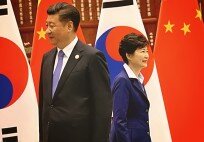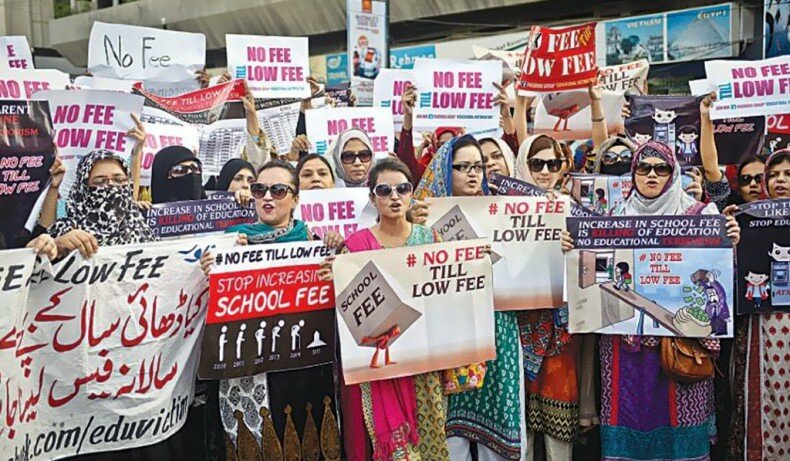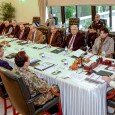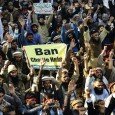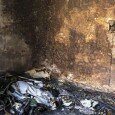By Sidrah Roghay
Saba*, a parent, pays Rs 80,000 as school fee for three children who attend the Beaconhouse School System. That’s a lot of money even for her well-to-do family which owns a profitable business.
Somewhere along she thought this had to stop. So along with 40 other parents she decided to launch a protest last Wednesday outside the Karachi Press Club.
 They made an odd group. They arrived in flashy cars, spoke fluent English and many owned profitable businesses. Most people who protest outside the cluttered road at Press Club, are looking for missing relatives, asking for jobs and demanding for a roof to live under—bare necessities for their survival.
They made an odd group. They arrived in flashy cars, spoke fluent English and many owned profitable businesses. Most people who protest outside the cluttered road at Press Club, are looking for missing relatives, asking for jobs and demanding for a roof to live under—bare necessities for their survival.
The group called private schools ‘a mafia’ and stated that they ‘the parents’ were not ‘ATM machines’.
Many had brought with them fee vouchers of their school children. Parents were paying as much as Rs 15000 for a child enrolled in kindergarten.
Ayesha, a mother who sent her child to the City School said that she was paying Rs 30,000, for two months for her child who goes to primary school. In order to meet these mounting expenses she had to work with her husband— and they had no time to spare for their children.
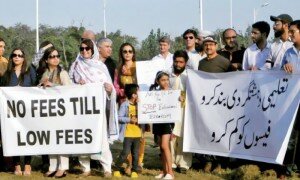 The wave of protests began after parents discovered that school fees had increased by 25 to 30 percent at the start of the academic year in August. And that the school management had refused to cooperate with them.
The wave of protests began after parents discovered that school fees had increased by 25 to 30 percent at the start of the academic year in August. And that the school management had refused to cooperate with them.
As soon as the protest ended the Sindh Education department sprung to action, as if they did not know about this issue till now. The Education Minister Nisar Khuhro called a press conference the very next day.
He blasted these schools for charging exorbitant fees to students. He maintained that these O-Level schools made only 12 percent of the total private schools in the province.
He reverberated that schools could only increase their fees by 10 percent each year. A notice was sent to 26 schools asking them to take back the increased fee, local media reported.
At the same time, he added, that all private schools had to teach 10 percent students free of cost.
Schools could feel the brunt, with their names splashed across the television screens, newspapers and social media.
Some like the City School decided to bury their head in the sand like an ostrich. Their Assistant Regional Director Mahvish Abrar, refused that the protesting parents had anything to do with their school.
 “None of the protesting parents are taking our name. We do not charge extra for books, security etc. However, we will hold a meeting over the issue shortly,” she said.
“None of the protesting parents are taking our name. We do not charge extra for books, security etc. However, we will hold a meeting over the issue shortly,” she said.
The Beaconhouse School System decided to get defensive. Their communication head Tabraiz Bokhari said that their running costs had gone very high due to the apathy of the government. “The electricity tariffs have gone up. There is no electricity so we have to buy generators. The government refuses to provide us security so we have to hire our own security guards and raise the walls of our schools.”
He added that he empathizes with the protesting parents, because their average disposable income has gone low. “We are a private entity and we have to transfer our costs to the parents.”
At the same time he added that his school was providing quality education, which led students to prestigious colleges and so improved their chances of living a better life.
There was a time when Karachi bustled with private schools which catered to the middle classes. There were convents like St. Josephs and St. Patricks and schools run by the Parsi administration like the Mama Parsi School.
These schools which charge nominal fees are still teeming with students. Every year several hundred students are rejected. But population in the city has increased exponentially and these schools are not enough anymore.
Surveys suggest that more than 90 percent students in the city attend private schools. Much of the brunt is borne by low cost private schools which charge between Rs500 to Rs2000 every month.
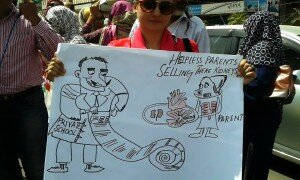 A recent study by Alif Ailaan, found out that it costs R 80,000 a year for a parent to educate a child in a low cost private school. Considering the annual GDP of Pakistan is Rs 150,000 an average parent is paying more than half of his income to educate his child.
A recent study by Alif Ailaan, found out that it costs R 80,000 a year for a parent to educate a child in a low cost private school. Considering the annual GDP of Pakistan is Rs 150,000 an average parent is paying more than half of his income to educate his child.
Parents who made it to the protests agreed to the survey. They said that their children’s education had dug deep holes in their pockets.
Tracing the O Level School
It was in the early 1980s when Zia ul Haq began denationalizing schools which Bhutto had nationalized. There was a gap in the market for quality education and several private entrepreneurs stepped forward to help educate children, states a paper ‘Education in Pakistan’ by the Strengthening Participatory Organization.
While these private schools were always for-profit entities—profit was not their sole purpose.
“The problem with these [elite] schools is that they want to open six more branches and its cost is being borne by one student,” said Bela Reza Jamil, who authors the respected Annual Status of Education Report every year.
“The amount of fee they are charging parents is crazy. There has to be some rationality in what they charge parents even if they are private entities,” she said.
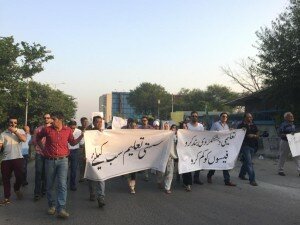 The solution she said was regulating these schools. “The regulatory body should have parents, school representatives and government officials. Any fee raise should be in consultation with all stakeholders, so that at the end of the day the consumer [student] benefits.”
The solution she said was regulating these schools. “The regulatory body should have parents, school representatives and government officials. Any fee raise should be in consultation with all stakeholders, so that at the end of the day the consumer [student] benefits.”
Protest Continues
Parents however have decided not to put their foot down. They will protest till schools agree to meet their demands— until then they will not pay any fee.
“I will not pay any fee till the school decides to listen to my demands,” said a parent who sends her daughter to the Foundation Public School. “The last I went to the principal complaining about the raise in fee, she told me I could chuck my girl out of school. Her attitude was demeaning and I have taken it personally. ”
*name protected at request of parent
The writer is a Karachi-based journalist




















































